Unsure about your French table manners? Click Here to download > > How to avoid these 10 food etiquette mistakes !
- Home ›
- Destinations ›
- Lyon ›
- What is Lyon famous for?
What Is Lyon Famous For? 17 Strong Arguments For Stardom
Published 9 July 2023 by Leyla Alyanak — Parisian by birth, Lyonnaise by adoption, historian by passion
Here's your answer to the question: "What is Lyon famous for?"
Lyon is one of those places that a lot of people have heard of but don’t necessarily know much about – unless they’ve been there.
Yet France’s second city is a dynamo, a brilliant cultural gem that is underrated because… I’m not sure why, actually.
Perhaps people rushing from Paris to Provence want to get there in a hurry and not get waylaid... That could be part of the reason.
But another, more important one, is that Lyon is simply not that well known. When you read about France, Lyon isn't the first destination that comes up, is it.
If people only knew what they were missing, they might make a beeline for France’s second city (this ranking is disputed by Marseille, by the way, but you can make the case for both, depending on how you calculate).
Ready for your Lyon trip?
Here are some suggestions to make your visit even more enjoyable!
TOP LYON CITY TOURS
➽ Vieux Lyon 4-hour Food Tasting Tour - for inveterate foodies and gastronomes
➽ Discover Lyon Walking Tour - to explore the essence of the city
LYON DAY TRIPS
➽ Golden Stones Beaujolais - heart of the Golden Stone villages for wine lovers
➽ Northern Côtes du Rhône - meeting the winemakers
➽ Beaujolais and Pérouges - wine tasting and a medieval village visit
WHERE TO STAY IN LYON
➽ Villa Florentine - stunning 5-star luxury overlooking the entire city
➽ Mi-Hotel Tour Rose - perfect apartments in historic Vieux Lyon
➽ Fourvière Hotel - elegant simplicity in a former cloister
➽ Hotel du Théatre - budget option in the heart of the classical district
Renting a car in Lyon? Compare prices here.
Traveling here by train? Book your ticket here.
To see the city, don't forget to book your Lyon City Card.
- 1. Lyon is the capital of gastronomy
- 2. It has renowned food markets
- 3. Lyon was the European capital of silk
- 4. The city is full of secret passages
- 5. La Résistance was headquartered here
- 6. It was the capital of Gaul
- 7. Fourvière Basilica, 19th-century wonder
- 8. The Festival of Lights
- 9. Lyon played a major role in cinema
- 10. Its monumental outdoor art
- 11. A vibrant cultural scene
- 12. Noteworthy architecture and urban planning
- 13. It’s where two rivers join
- 14. It is home to the Olympique Lyonnais
- 15. There be puppets!
- 16. Lyon has a Little Prince connection
- 17. The cathedral... and its astronomical clock
FAQ: What is Lyon famous for?
So in the end, what is Lyon famous for?
I live near Lyon and it excites me to visit because each time, I discover something new, and that something is often spectacular.
So let’s try to nail it: what IS Lyon best known for? Once you know, you may be tempted to visit. And once you visit, you’ll be back. Again and again.
What is Lyon famous for?
You’ll be surprised at the length of this list! So, here goes.
1. Lyon is the capital of gastronomy
This is probably the most famous Lyon city claim to fame and it has been known for its cuisine, home of specialties which together make up the Cuisine Lyonnaise.
Not only is Lyon food famous, but so are its individual dishes like quenelle de brochet (pike dumpling), Salade Lyonnaise, and plenty of pork and offal-based dishes like tripe.
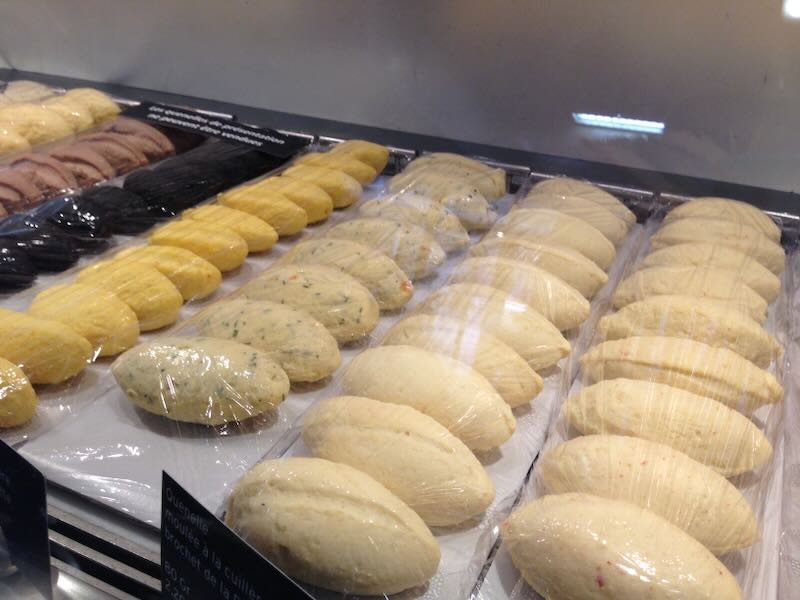 Various types of "quenelle", a Lyon specialty
Various types of "quenelle", a Lyon specialtyWith its 16 Michelin-starred restaurants, Lyon can also lay claim to famous chefs. Paul Bocuse, named chef of the century, was born just north of here and spent his life building up the restaurant that bears his name.
His mentor was none other than Eugénie Brazier, who was the first woman to earn three Michelin stars and revolutionized Lyonnaise cuisine by offering simpler, lighter dishes. Why not discover some of Lyon's food specialties by taking a food tour?
2. It has renowned food markets
The city is famous for its vibrant food markets, both indoor and out.
The Marché Saint-Antoine Célestins along the Saône has wonderful produce and great cheeses and yes, you just might find a chef or two squeezing the tomatoes here (keep walking and you’ll end up at the outdoor second-hand book market).
Then there’s the market on Croix-Rousse, the silk-weavers’ hill, with its flowers and regional specialties, and the Marché Carnot, for the most local produce.
Not exactly a market but a fabulous indoor food hall is Les Halles Lyon Paul Bocuse, the most upmarket food emporium and one of the best places to see in Lyon, with all the “big houses” of the city and their cheeses, charcuterie and pastries.
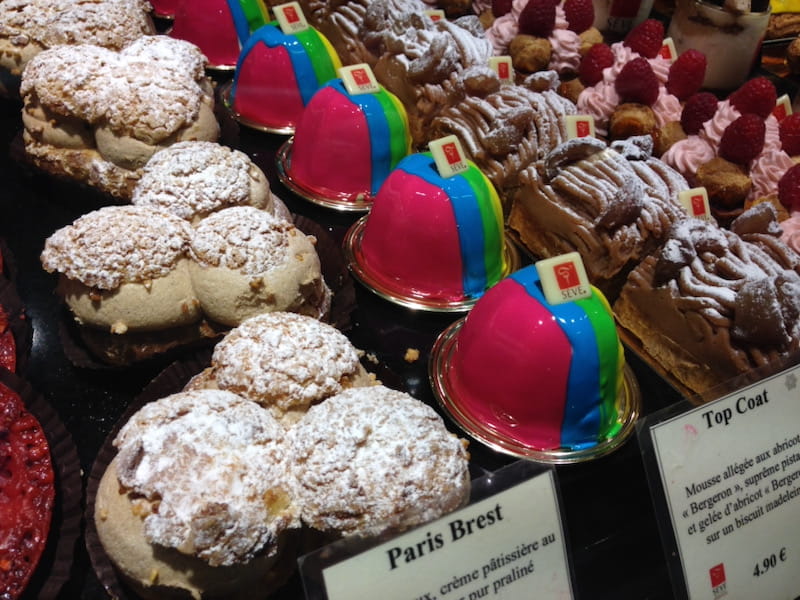 Pastries on display at Les Halles Paul Bocuse in Lyon
Pastries on display at Les Halles Paul Bocuse in LyonAnd possibly the most fun culinary event of the year is the Lyon Street Food Festival, a fun event which brings together gastronomes from food truck owners to major chefs to prepare some of their signature dishes for those who would like to get to know them but haven’t been to their major restaurants.
 Each year, the Lyon Street Food Festival gathers everyone from starred chefs to street food cooks in a mammoth festival that I try never to miss!
Each year, the Lyon Street Food Festival gathers everyone from starred chefs to street food cooks in a mammoth festival that I try never to miss!3. Lyon was the European capital of silk
When exploring the question of what is Lyon known for, silk rises to the top of the list.
For centuries, Lyon was the capital of the European silk trade, known for its silk production and weaving techniques. Master weavers had been brought in from Italy, and the industry grew, with Lyon’s massive trade fairs attracting merchants from across Europe.
By the mid-17th century there were 14,000 looms in the city and the silk industry was responsible for the wellbeing of a third of the population.
Silk prices eventually fell (the Industrial Revolution and the introduction of machines helped) and the workers rebelled, in one of the first industrial workers’ strikes in France.
You can learn all about Lyon’s traditional silk production process at the Maison des Canuts, a silk weaving museum and workshop or by taking a silk walking tour.
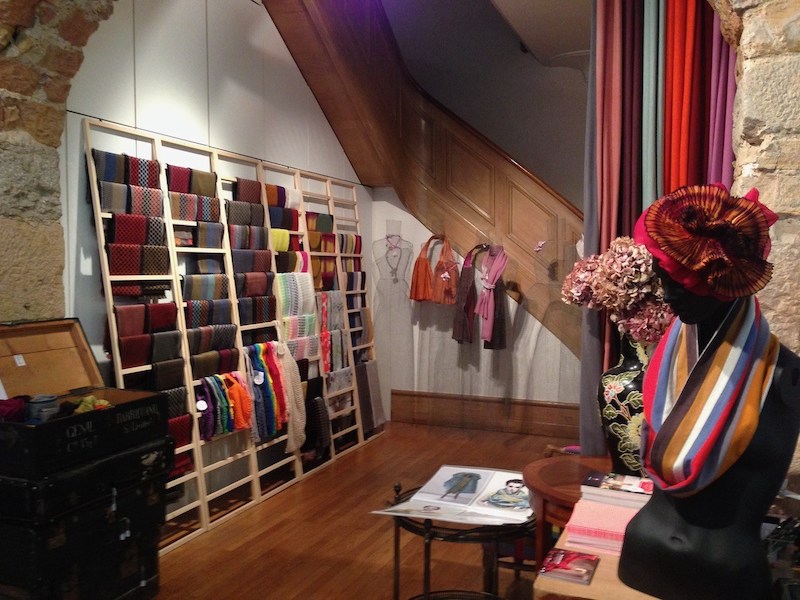 One of the many silk shops you'll find scattered around Lyon
One of the many silk shops you'll find scattered around Lyon4. The city is full of secret passages
Silk traders had to ferry their bolts of silk from the workshops on the hill to the shops below.
All those bolts of silk had to stay dry when it rained so silk workers used hidden passageways – called traboules – that still connect streets and courtyards today.
The traboules also served as hiding places during World War II for members of the French Résistance, and some of the best traboules to visit in Lyon can be found in the Old Town.
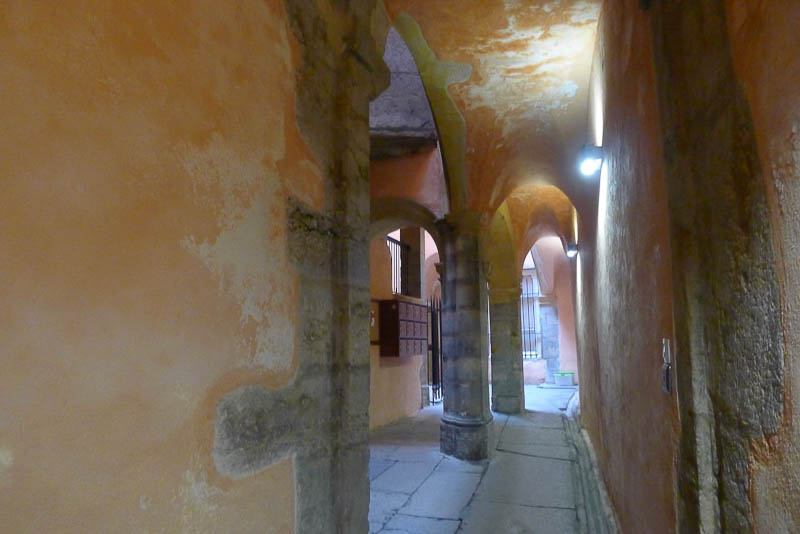 One of the many traboules, or secret passages, throughout Old Lyon
One of the many traboules, or secret passages, throughout Old Lyon5. La Résistance was headquartered here
Members of the Résistance during World War II used the traboules and many other corners of their city to fight the Nazis. Lyon was famous for its role in the French Resistance during World War II, with significant historical sites and monuments commemorating the resistance movement.
A well-designed museum (Centre d'Histoire de la Résistance et de la Déportation) is one of the more famous places in Lyon. Not only is it a museum that details Lyon’s resistance to the Nazis, but it is located right in the building which served as Gestapo headquarters during the war.
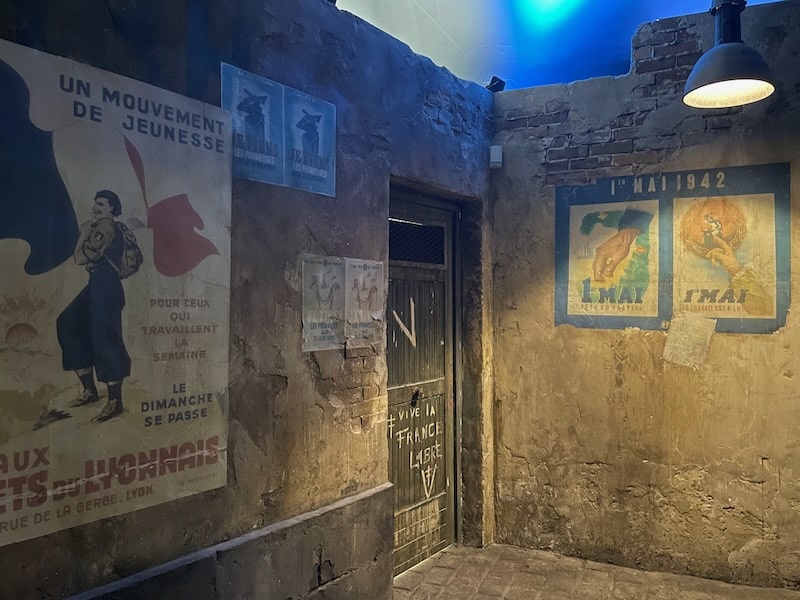 A re-created room belonging to the Résistance on show at the museum
A re-created room belonging to the Résistance on show at the museum6. It was the capital of Gaul
Lyon is blessed with an ample collection of Gallo-Roman ruins, mostly built during the first century CE when Lyon was called Lugdunum.
These ruins are well preserved and showcase a Grand Theater and a smaller Odeon, all open for us to wander around. Performances are still held here today – in summer, the Nuits de Fourvière (Fourvière is the name of the hill on which the ruins lie) feature world-renowed artists against the magical backdrop of Ancient Rome.
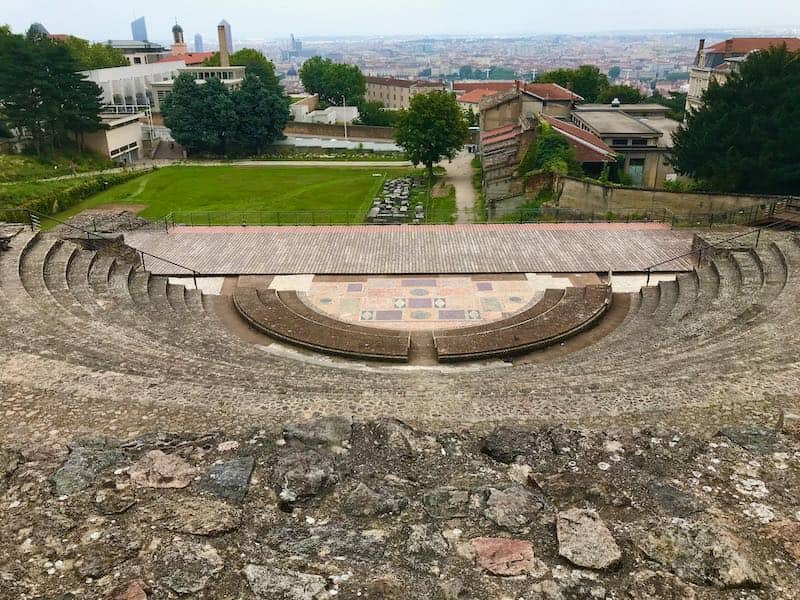
Hidden in the grassy hills around the ruins is a Gallo-Roman museum with excellent displays of the many artefacts and rich history of Rome in Lyon. Shaped internally like a spiral, you start at the top and work your way down from one display to the next.
7. Fourvière Basilica, 19th-century wonder
Behind the Roman ruins, a block away, is the Basilica of Notre-Dame de Fourvière, one of the most famous landmarks in Lyon, one which you can usually spot from most corners of Lyon. People visit here for two reasons: for the basilica itself, and for the panoramic views of Lyon you can get from its gardens.
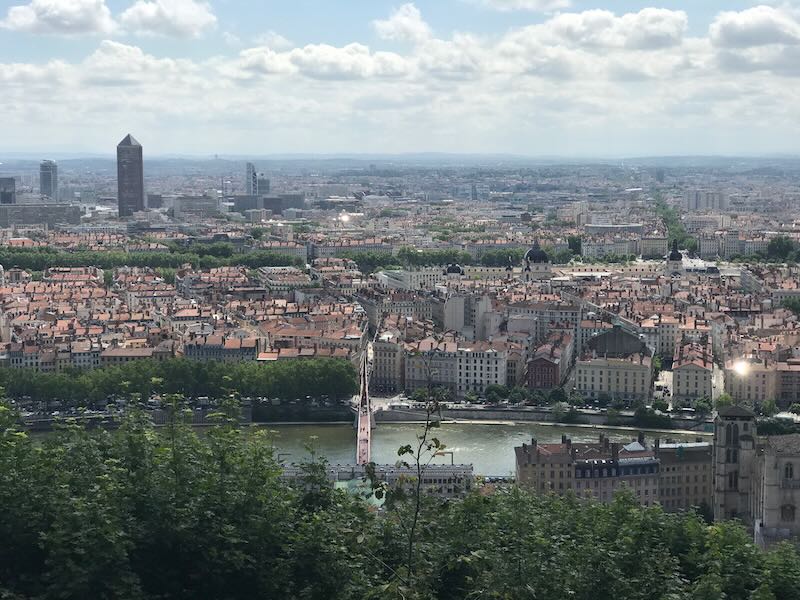 Just an idea of what you can see from Fourvière Hill...
Just an idea of what you can see from Fourvière Hill...In the mid-17th century, when the bubonic plague spread across Europe, the Virgin Mary is believed to have interceded and saved the people of Lyon. The same thing happened during a cholera epidemic two centuries later. And during the Franco-Prussian War (1870-71), after the Prussians had marched on Paris, Lyon avoided capture and again, survival was attributed to the Virgin Mary.
To give thanks to Mary, the Lyonnais decided to build the Fourvière Basilica, and in early December each year, they thank her by lighting candles throughout the city.
An intriguing little addition is the little metallic tower that sits next to it – it is often likened to a mini Eiffel Tower. It was built as a restaurant during the World’s Fair in 1894 but today, it serves as a communications hub.
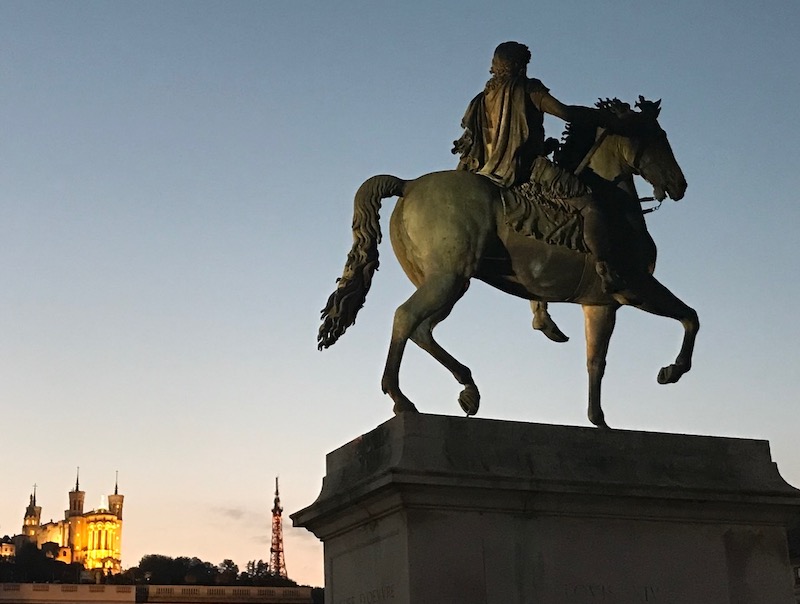 Louis XIV equestrian statue and in the background, the Fourvière Basilica and the mini-Eiffel Tower
Louis XIV equestrian statue and in the background, the Fourvière Basilica and the mini-Eiffel Tower8. The Festival of Lights
This candle-lighting tradition has evolved into the Festival of Lights (Fête des Lumières), which attracts millions of visitors every year and is famous for its spectacular light displays.
While the event is crowded and chilly, the light show is indeed spectacular, each year different from the next, and absolutely worth experiencing at least once in your lifetime.
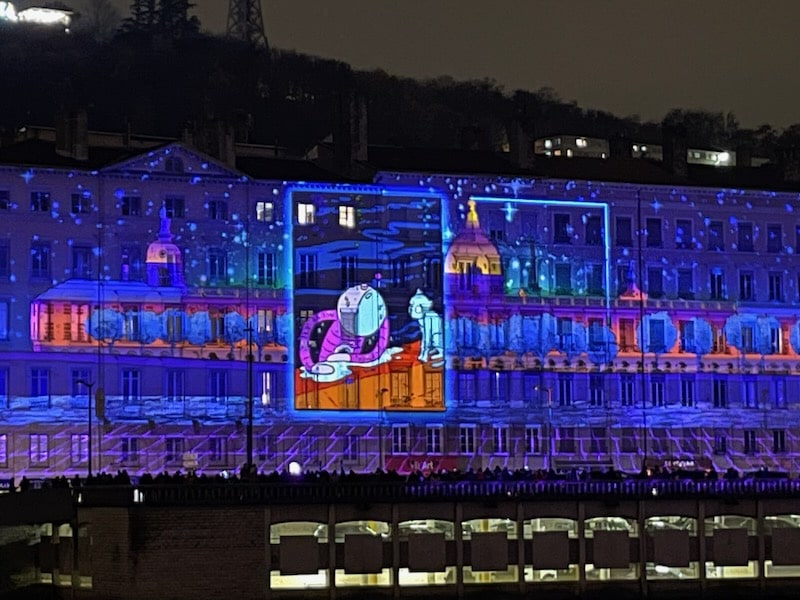 The light displays during the Festival of Lights run the range from quirky to classical
The light displays during the Festival of Lights run the range from quirky to classical9. Lyon played a major role in cinema
Lyon is renowned for its role in the development of cinema: it was the birthplace of the Lumière brothers, who invented the cinematograph in 1895, the world’s first viable film camera.
To trace its history, you can visit the Lumière Institute, which pays homage to the brothers and showcases the history of cinema through various exhibits and screenings.
Every year, Lyon’s Lumière Film Festival celebrates classic and contemporary cinema and attracts renowned filmmakers and actors from around the world.
Lyon is also known for its prestigious Lumière Awards, which honor exceptional achievements in the world of cinema.
Wherever you look in this city, you’ll feel its connection to cinema.
10. Its monumental outdoor art
One thing Lyon is famous for is its outdoor art scene.
Its vibrant street art scene, with numerous murals and graffiti, decorates many city walls. However talented these artists, the real artistic draws in Lyon are the more than 150 giant murals that dot the city.
A number of the more spectacular ones are downtown, making them easy to view. One of the most popular Lyon murals is the Fresque des Lyonnais, which depicts famous citizens of Lyon in various poses, leaning against balcony railings.
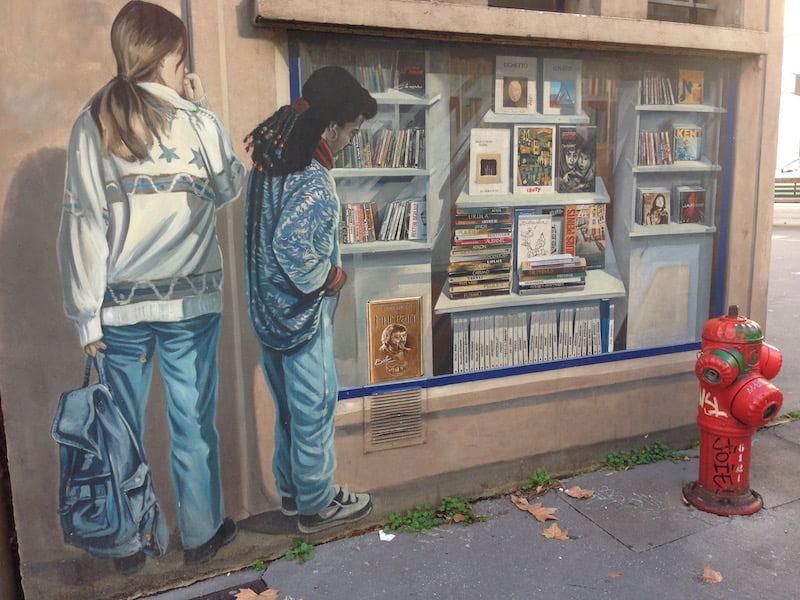 One of many of Lyon's outdoor murals
One of many of Lyon's outdoor murals11. A vibrant cultural scene
Like any city of its rank, Lyon has an exciting cultural scene, with numerous theaters, an opera house, and world-class museums.
Particularly noteworthy are the many cultural festivals held in Lyon:
- the Biennale de Lyon, an international contemporary art exhibition
- the annual Nuits Sonores electronic music festival
- the Festival of Contemporary Dance (Biennale de la Danse)
- the Lyon Comic Festival, which celebrates the world of comics
- the annual Festival of Ancient Music, with classical performances from a variety of historical periods.
12. Noteworthy architecture and urban planning
Lyon is an architect’s delight, particularly celebrated for its UNESCO-listed Renaissance (and medieval) architecture in Lyon Old Town.
But it also leads the way in innovative urban planning. It built the first skyscrapers in France, in the suburb of Villeurbanne, to house the city’s industrial workers.
More recently, the iconic so-called Crayon building caps the skyline with its pencil-like point, not to mention avant-garde neighborhoods like Confluence (famous for its sustainability) and the Cité Internationale complex, or the enlargement of the Lyon Opera by adding a dome to the top of the then classical building.
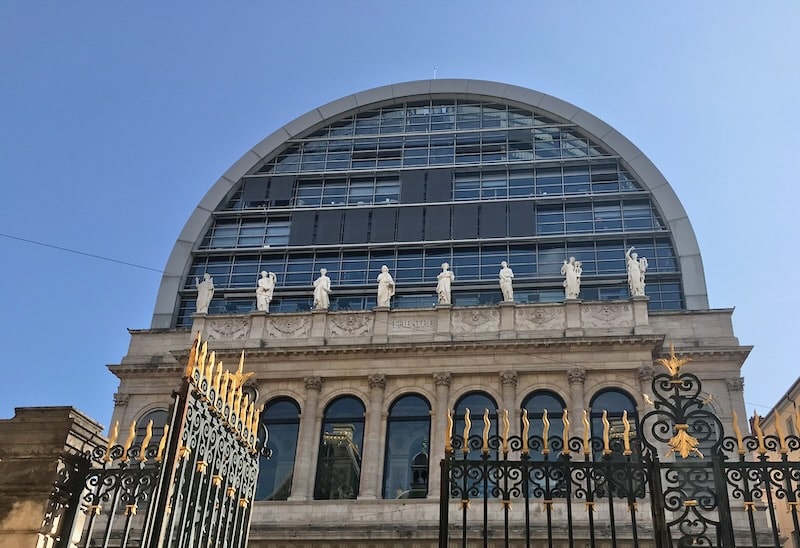 You can see how unusual it was to add a dome to an otherwise classical building, the Lyon Opera
You can see how unusual it was to add a dome to an otherwise classical building, the Lyon Opera13. It’s where two rivers join
Many cities have a river but Lyon has two, the Rhône and the Saône, and they both meet here, right in front of the modern, metallic wing-like museum of Confluences, in the neighborhood of the same name.
The riversides are put to good use, with markets and book fairs and plenty of houseboats that have been turned into bars and restaurants. There’s also talk of turning parts of the riverside into beaches, just like the temporary summer beaches in Paris.
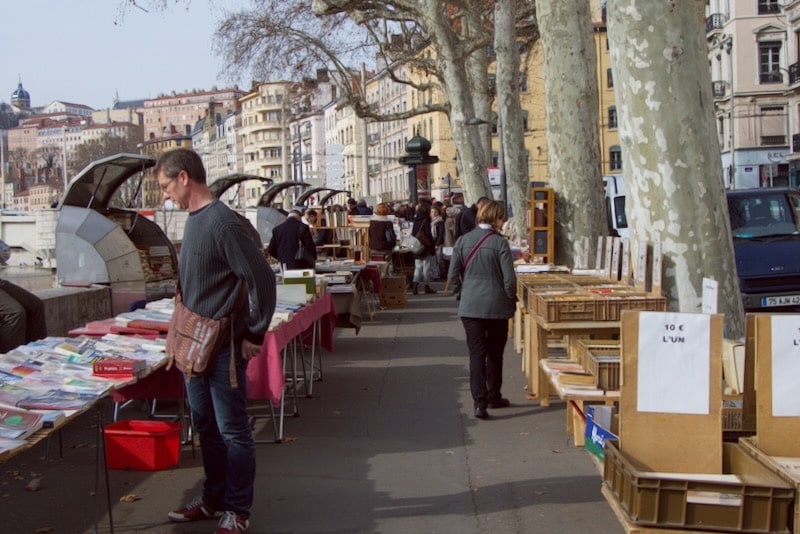 Strolling along the riverside in Lyon, looking for second-hand books
Strolling along the riverside in Lyon, looking for second-hand booksOf the two, the Rhône appears to have the more classical, elegant architecture while the banks of the Saône are more lively and, somehow, Mediterranean.
14. It is home to the Olympique Lyonnais
The renowned Olympique Lyonnais football club (European football) is one of the most successful football clubs in France, having won many titles and awards. More informally, it’s called the OL, or oh-ell.
15. There be puppets!
Guignol is France’s best-known puppet, a sort of local Punch-and-Judy, and he’s from Lyon.
He was fashioned in the 19th century to represent a canut, or silk worker (his creator was a silk worker) and is still entertaining children and adults of all ages.
Lyon has honed the art of puppetry and Guignol is now a cultural icon, whom you can get to know better at the city’s Gadagne Museum, or at the smaller Petit Musée de Guignol, both in the Vieux Lyon.
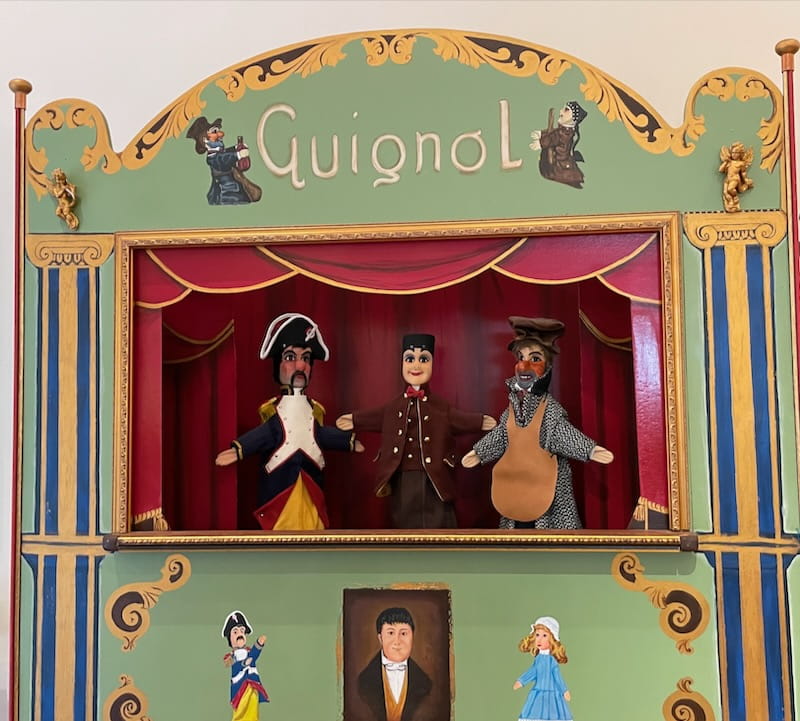
16. Lyon has a Little Prince connection
The city is connected to the famous French novelist Antoine de Saint-Exupéry, author of "The Little Prince," who was born in Lyon. The Little Prince is believed to be the world’s most widely read non-religious book.
Here and there, across Lyon, there are reminders of the aviator – a statue, a street name, and even a shop.
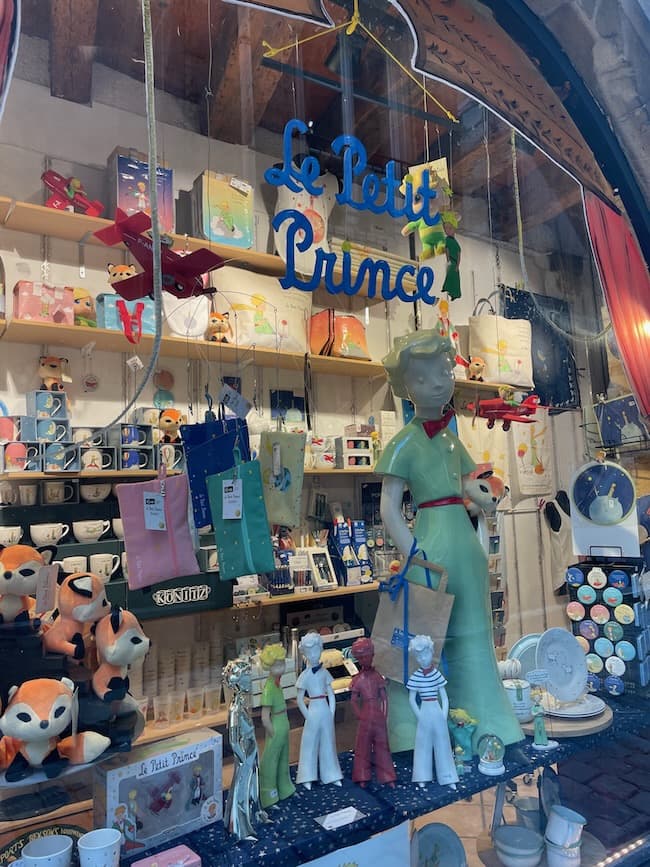 The Little Prince in Old Lyon
The Little Prince in Old Lyon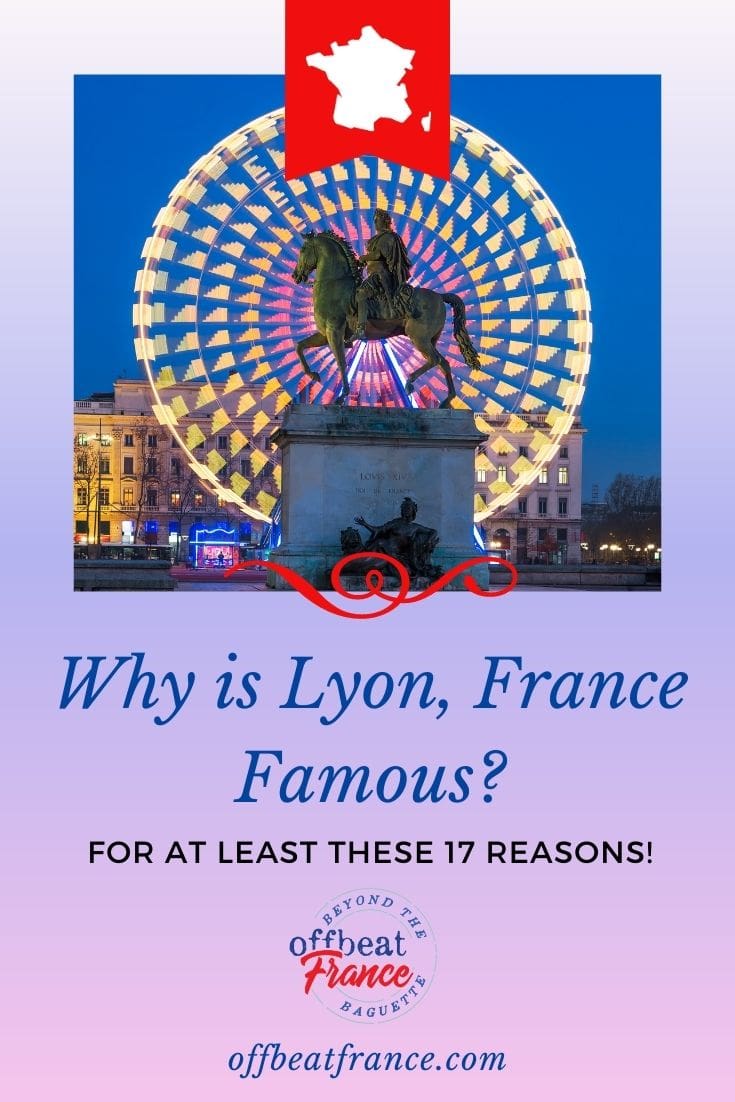
17. The cathedral... and its astronomical clock
The Cathédrale Saint-Jean-Baptiste is already noteworthy, with its mix of Romanesque and Gothic architecture. But one unusual and special feature of the cathedral is its astronomical clock, with its perpetual and religious calendar.
It dates back to at least 1383, making it one of the oldest in Europe. Sadly, it has been under repairs for a decade, since it was vandalized, but the exterior has now been spruced up and the scaffolding removed. Work is ongoing on the mechanism but even if it's not working, it is a work of art worth seeing up close.
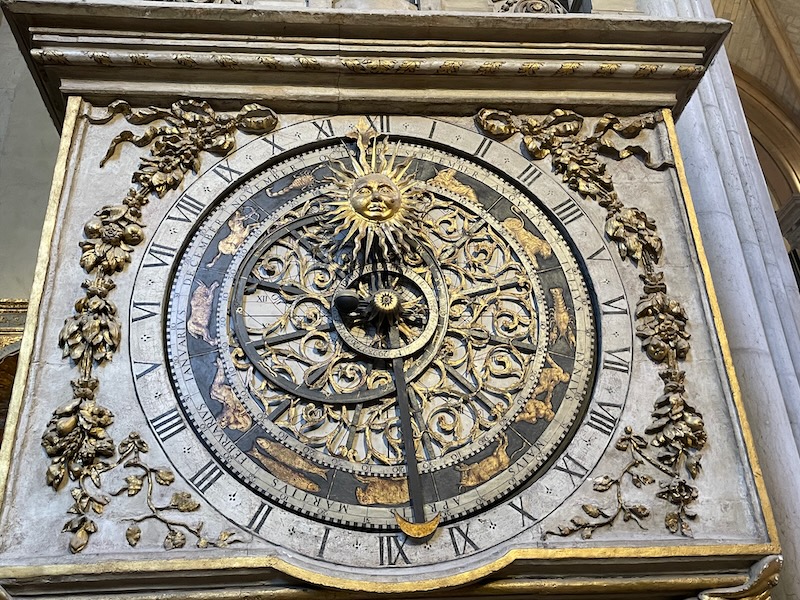
So what is Lyon famous for?
There are so many noteworthy things to see in Lyon that choosing one thing that makes the city famous is an unreasonable task.
But if I were to single out the thing most visitors might know about before they visit, I would have to say food. Lyon’s culinary fame is global, and you’ve probably heard about Lyon’s food specialties, or perhaps even tried some!
When you visit, though, you’ll understand more about what Lyon is known for
FAQ What Lyon is known for
What is unique about Lyon France?
So many things! Its architectural heritage and impressive landmarks, include several areas under UNESCO protection; the food and the city's reputation as the gastronomical capital of France; traboules, or hidden passageways; massive murals; the Fête des Lumières in December; silk production; the hyper-modern Confluence district; and its location as a gateway between northern and southern France and proximity to Switzerland and Italy.
What is Lyon France like?
Lyon is physically attractive, with two rivers passing through it and several hills that each have a different personality. As a city, it is vibrant and fascinating, with plenty of culture and art, and an energy that makes a visit a true discovery.
Is Lyon worth visiting?
Absolutely yes! Once you’ve seen Paris, if you’d like to get to know other world-class French cities, Lyon should top your list.
What are some important facts about Lyon France?
Lyon is known as the culinary capital of France. It is filled with amazing architecture, the hot air balloon was invented here (so was the cinematograph, the world’s first film camera), and it was once the silk-making capital of Europe.
The historic part of the city has been listed as a UNESCO World Heritage Site since 1998. The protected areas include the Roman district and Fourvière, the Renaissance area (Vieux Lyon), the silk district (slopes of Croix-Rousse), and the Presqu’île, which contains a large number of 19th-century buildings. Here are plenty more facts about Lyon.
Where is Lyon located?
Lyon is in southeastern France, in the Auvergne-Rhône-Alpes region, one of the country's 18 administrative regions.
Lyon is 470 kilometers (290 miles) southeast of Paris and lies between two major rivers, the Rhône and the Saône.
Lyon is located north of the French Riviera, west of the French Alps, and southwest of Geneva, Switzerland.
How do you spell the city – Lyon or Lyons France?
In French, the city is spelled Lyon, without an "S". However, in English, it is sometimes spelled with the additional "S". Why is that?
In long-ago days, the "S" was actually part of medieval French spelling but was eventually dropped in French, but remained in English.
Why is Lyon famous for silk?
Lyon's fame for silk production dates back to the 15th century. The city's strategic location where major European trade routes converged made it a key hub for the silk trade.
In 1466, King Louis XI decided to reduce France's dependency on Italian silk, which was a major import at the time, by developing a national silk industry in Lyon. To kickstart the industry, he brought 200 Italian silk workers to Lyon.
By the 16th century, Lyon had become Europe's silk-making capital. The city was producing a variety of high-quality silk products, including fabrics, ribbons, and tassels, which were exported to markets throughout Europe and beyond. Silk was also much in demand at the court of Louis XIV in Versailles, which set the fashion scene for many other royal courts.
Despite several challenges, such as the silk workers' revolts in the 19th century and the decline of the silk industry in the 20th century because of competition from synthetic fibers, Lyon's silk tradition has endured.
Today, the city still houses several workshops and businesses dedicated to silk production in the Croix-Rousse neighborhood, where silk workers once lived and worked.
Silk remains an important part of Lyon's cultural and industrial heritage. Lyon's Museum of Textiles is dedicated to the city's rich history of silk production and textile artistry.
Why is Lyon famous for food? What food is Lyon famous for?
Several factors have influenced Lyon's culinary fame.
Geographically, it is located in a fertile region with an amazing array of high-quality local ingredients, including poultry, freshwater fish, produce and wines.
Historically, the silk workers of this prosperous commercial city began the tradition of "mâchons", hearty morning meals. Then came the "bouchons" — small, casual restaurants serving traditional, richly flavored dishes, many of which still exist today.
In the 19th and early 20th centuries, women chefs known as "Les Mères Lyonnaises" or "The Mothers of Lyon" opened restaurants serving traditional local cuisine, which became highly regarded for their quality. These women, many of whom started as domestic cooks, had a significant impact on the culinary scene in Lyon, and their influence continues to be felt today.
Over time, a number of influential culinary figures emerged from Lyon, including Eugénie Brazier, "La Mère Brazier", the first woman to earn three Michelin stars and mentor to Paul Bocuse, a pioneer of "nouvelle cuisine".
How did Lyon France get its name?
Lyon is derived from the original Roman name for the city. Originally called Lugudunon by the Roman colonists who settled here, the name was quickly latinized to Lugdunum to publicize Rome's power over the region. The name evolved to Lugduum, then Lydiuum, and finally, around the 13th century, it became Lyon.
In French, the word "lion" means lion, the animal. It may be spelled differently than the city but it is pronounced the same way, so it's not surprising that Lyon eventually adopted the animal "lion" as its official emblem.
How old is Lyon? When was Lyon founded?
The site where Lyon stands has been inhabited since prehistoric times, but the first city, Lugdunum, dates from 43 BCE.
Was Lyon the capital of France?
Lyon has never officially been the capital of France – that title goes to Paris. However, Lyon is often called the "capital of the Gauls" because during the Roman Empire, it was the capital of the province of Gallia Lugdunensis, which covered a large part of what is now France. The city was known as Lugdunum in Latin, and it was one of the most important cities in the Western Roman Empire.
In more recent history, Lyon was the center of the French Resistance during World War II, and some might metaphorically refer to it as a "capital" in that context. But this is more of a symbolic or honorary title, not a formal political designation.
What makes Lyon special when compared to other cities such as Paris and Bordeaux?
Comparing Lyon to Paris is a bit like comparing apples and oranges, because Paris is the capital, after all, and stands a head and shoulders above the rest of France. However, Lyon is often compared to Bordeaux, and that is a far better comparison.
What to buy in Lyon?
Most people will say food, because that is Lyon's most famous speciality. There are plenty of candies, like pralines or the famous Coussins de Lyon (Lyon cushions, made from chocolate ganache and Curaçao liqueur) that can be wrapped up for travel, for example, if you are not allowed to bring in meats or cheeses. Another excellent buy is silk, and there are shops all around Lyon.
And wine from the Beaujolais and the Côtes du Rhône, of course!
What festival is Lyon famous for?
Lyon has many festivals but the most famous is the Festival of Lights, which takes place in early December and involves lighting up the façades of buildings all over Lyon.
Before you go...
I hope I've convinced you that my adopted city is worth the visit – but you'll have to see for yourself! If you happen to be a foodie (and many visitors to Lyon ARE!) then please have a look at my overview of France's favorite foods, to make sure you try them all when you visit.
Did you enjoy this article? I'd love if you shared it!


